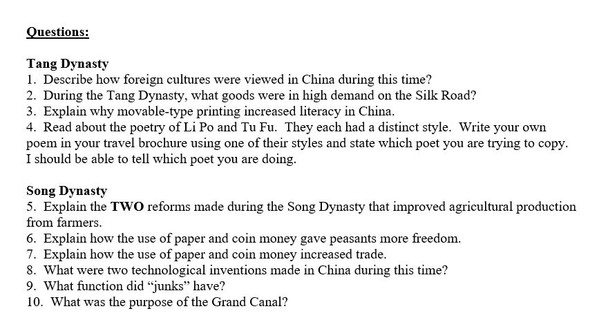Description
This lesson plan covers both the Tang and Song Dynasties of Medieval China. By the end of the lesson, students will understand: a. the "tribute" system used in the empire. b. the effect Confucianism had on Chinese culture, including the practice of foot-binding c. and Chinese cultural and technological developments
This lesson includes both a Powerpoint and a 3 page article.
For the Tang Dynasty, the article explains the significance of Silk Road trade routes, the development of the porcelain, jade pottery, and silk-weaving industries, and the invention of the movable-type printing press. In addition, the article explains the cultural contributions of Medieval China's most famous poets, Li Po and Tu Fu.
For the Song Dynasty, the article explains the significance of the creation of paper and coin money as well as technology innovations in ship-building, the Grand Canal, and gunpowder weapons.
For the lesson, the teacher first gives a short powerpoint that sets up Post-Classical China and the Tang and Song Dynasties. After the notes, the students will read the article and answer the accompanying guiding questions that come with the article.
Afterwards, students partner up to create a "travel brochure" (directions in power-point) where they illustrate and discuss 3 cultural and 3 technological achievements of Post-Classical China.
This lesson is perfect for any World History teachers in Texas as it directly addresses a TEK:
WH4 History. The student understands how, after the collapse of classical empires, new political, economic, and social systems evolved and expanded from 600 to 1450. The student is expected to: (H) summarize the major political, economic, and cultural developments in Tang and Song China and their impact on Eastern Asia
Created by Dan Nguyen - Visit My Store















